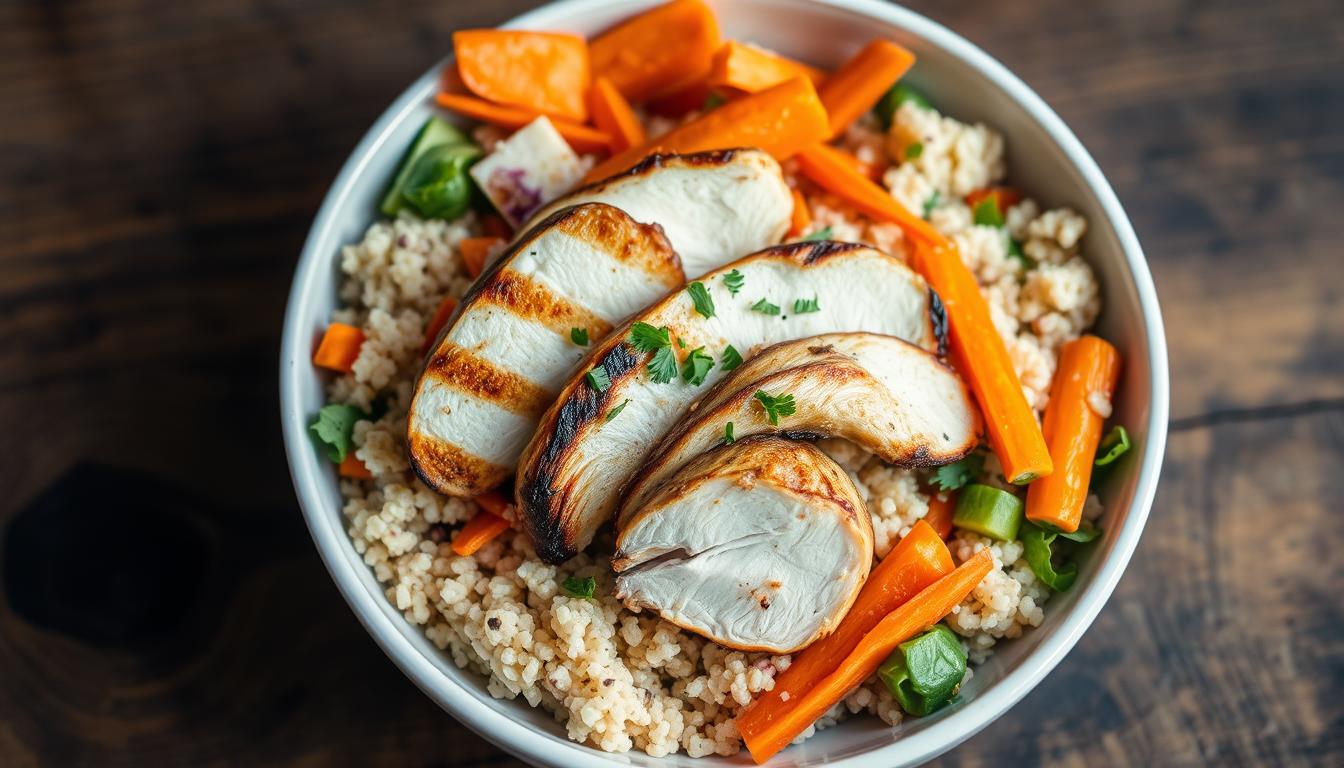Finding the right diet for endometriosis can be tough. But, a simple, healthy meal could help manage your symptoms. Our Endo-Friendly Chicken Quinoa Carrots dish is a tasty, anti-inflammatory meal that could improve your life.
Did you know 200 million women worldwide have endometriosis? It’s a big number, and we need to tackle this condition. Eating the right foods can help ease symptoms and boost our health.
In this article, we’ll explore endo-friendly eating and the benefits of our Chicken Quinoa Carrots recipe. You’ll enjoy a meal that’s not only tasty but also good for your body.
What is Endometriosis?
Endometriosis is a chronic, painful condition that affects up to 1 in 10 women during their reproductive years. It happens when tissue like the uterus lining grows outside the uterus. This tissue often grows on the ovaries, fallopian tubes, or other pelvic organs.
This misplaced tissue reacts to hormonal changes, causing inflammation, scarring, and adhesions. These can lead to severe pain and other symptoms that are hard to deal with.
Recent research shows that 44% of people with endometriosis in Australia use diet to manage symptoms. Eating dairy products may lower the risk of endometriosis, based on studies. A healthy Mediterranean diet and avoiding inflammatory foods can help symptoms.
But, eating red meat can increase the risk of endometriosis. Also, highly processed foods can lead to diseases like obesity and heart problems. So, an anti-inflammatory diet is key for managing endometriosis.
Understanding endometriosis and how diet affects symptoms can help improve life quality. It can also reduce the pain from this chronic condition.
Symptoms and Causes of Endometriosis
Endometriosis is a complex and often debilitating condition. It can significantly impact the lives of those affected. This chronic disorder is characterized by the growth of endometrial-like tissue outside the uterus. This leads to a range of symptoms and complications.
The most common symptoms of endometriosis include:
- Pelvic pain, which can be severe and debilitating, often occurring during menstrual periods or intercourse
- Heavy or painful periods, with excessive bleeding and cramping
- Infertility, as the endometrial-like tissue can interfere with the normal function of the ovaries and fallopian tubes
- Fatigue and digestive issues, such as bloating, constipation, or diarrhea
The exact causes of endometriosis are not fully understood. Research suggests it may be linked to a combination of factors, including:
- Retrograde menstruation, where menstrual blood and endometrial tissue flow backward through the fallopian tubes and implant on the pelvic organs
- Immune system dysfunction, where the body fails to recognize and remove the misplaced endometrial tissue
- Estrogen dominance, which can promote the growth and proliferation of the misplaced endometrial tissue
- Genetic predisposition, as endometriosis appears to run in families
- Chronic inflammation and an imbalance in the gut microbiome, which may contribute to the development and progression of the condition
Understanding the varied symptoms and causes of endometriosis is key. It’s important for seeking appropriate medical care and implementing effective management strategies. By addressing the underlying factors and adopting a holistic approach, individuals with endometriosis can alleviate their symptoms and improve their quality of life.
| Endometriosis Symptom | Prevalence |
|---|---|
| Pelvic Pain | 75-90% |
| Painful Periods | 60-90% |
| Painful Intercourse | 50-90% |
| Infertility | 30-50% |
| Fatigue | 60-90% |
| Digestive Issues | 40-60% |
The Importance of an Anti-Inflammatory Diet for Endometriosis
Following an anti-inflammatory diet is key for managing endometriosis. Foods high in antioxidants and omega-3 fatty acids help lower inflammation and pain. Eating nutrient-rich, whole foods and avoiding processed foods, sugar, and red meat can help control symptoms.
The Benefits of an Anti-Inflammatory Diet for Endometriosis
An anti-inflammatory diet offers several benefits for those with endometriosis:
- Less inflammation and pain
- Improved symptoms like pelvic pain and menstrual cramps
- Better overall health and quality of life
- Support for managing endometriosis
By eating more anti-inflammatory foods and less pro-inflammatory ones, we can help our bodies fight chronic inflammation. This may reduce some of the severe symptoms of endometriosis.
Along with diet, a healthy lifestyle is important. This includes regular exercise, managing stress, and getting support from healthcare professionals. An anti-inflammatory diet is a vital part of managing endometriosis, but it’s not the only solution.
Benefits of Endo Friendly Chicken Quinoa Carrots
The Endo Friendly Chicken Quinoa Carrots recipe is great for those with endometriosis. It’s packed with nutrients and helps manage symptoms of this chronic condition.
This dish combines protein from chicken, fiber from quinoa, and anti-inflammatory carrots. It can reduce inflammation, ease pain, and improve gut health. It’s also gluten-free and low in FODMAPs, good for those with digestive issues.
Studies show that eating fruits, like citrus, can lower endometriosis risk. Avoiding gluten also helps with symptoms. Drinking water is best for reducing inflammation. Dietitians can offer personalized nutrition advice for managing symptoms.
Adding this nutrient-dense and anti-inflammatory dish to your meals can help with symptom relief and overall health with endometriosis.
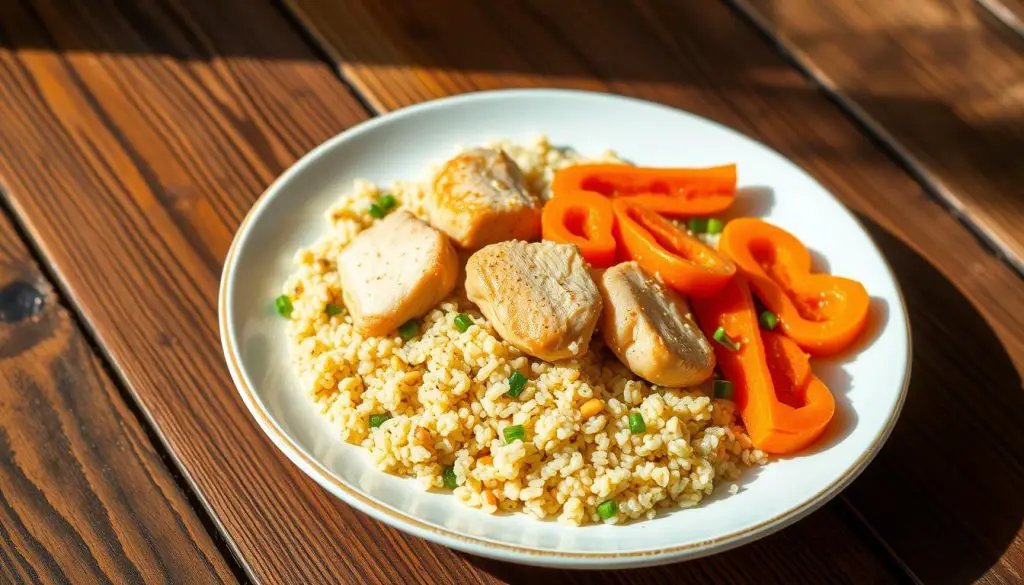
Ingredients for Endo Friendly Chicken Quinoa Carrots
The Endo Friendly Chicken Quinoa Carrots recipe is a mix of healthy and anti-inflammatory foods. These ingredients help support our well-being. Let’s explore the main parts of this dish:
Protein-Rich Chicken
Chicken is a lean protein that gives our bodies amino acids for muscle health and recovery. It’s a great choice for an endo-friendly meal because it’s low in inflammatory compounds.
Gluten-Free Quinoa
Quinoa is a versatile, gluten-free whole grain. It’s full of fiber, protein, and vitamins and minerals. It’s perfect for those on a low-FODMAP diet because it’s easy to digest and gentle on the gut.
Nutrient-Dense Carrots
Carrots are full of beta-carotene, an antioxidant that fights inflammation. They also have other beneficial plant compounds. This makes them a great addition to this endo-friendly dish.
The recipe also includes other anti-inflammatory foods like broccoli, spinach, olive oil, garlic, and onions. These endo friendly ingredients make a nutritious and anti-inflammatory meal. This meal supports our health and well-being.
Step-by-Step Recipe for Endo Friendly Chicken Quinoa Carrots
Making a healthy and endo-friendly meal is easy and tasty. Our Chicken Quinoa Carrots recipe is a great example. It’s an anti-inflammatory dish that can ease endometriosis symptoms. Let’s go through the steps to make this fulfilling meal.
- Preheat your oven to 400°F (200°C) and line a baking sheet with parchment paper.
- In a large bowl, toss together diced chicken, sliced carrots, and florets of broccoli with 2 tablespoons of olive oil.
- Season the mixture with minced garlic, fresh rosemary, thyme, salt, and black pepper to taste.
- Spread the seasoned chicken and vegetable mixture evenly on the prepared baking sheet. Roast in the preheated oven for 20-25 minutes, or until the chicken is cooked through and the vegetables are tender.
- While the chicken and vegetables are roasting, cook the quinoa according to the package instructions.
- Once the chicken and vegetables are ready, combine them with the cooked quinoa in a large bowl. Garnish with fresh chopped parsley and serve warm.
This endo friendly recipe is simple to make and full of anti-inflammatory ingredients. The mix of chicken quinoa carrots makes a nutritious and fulfilling meal. It’s perfect for those with endometriosis as part of a balanced diet.
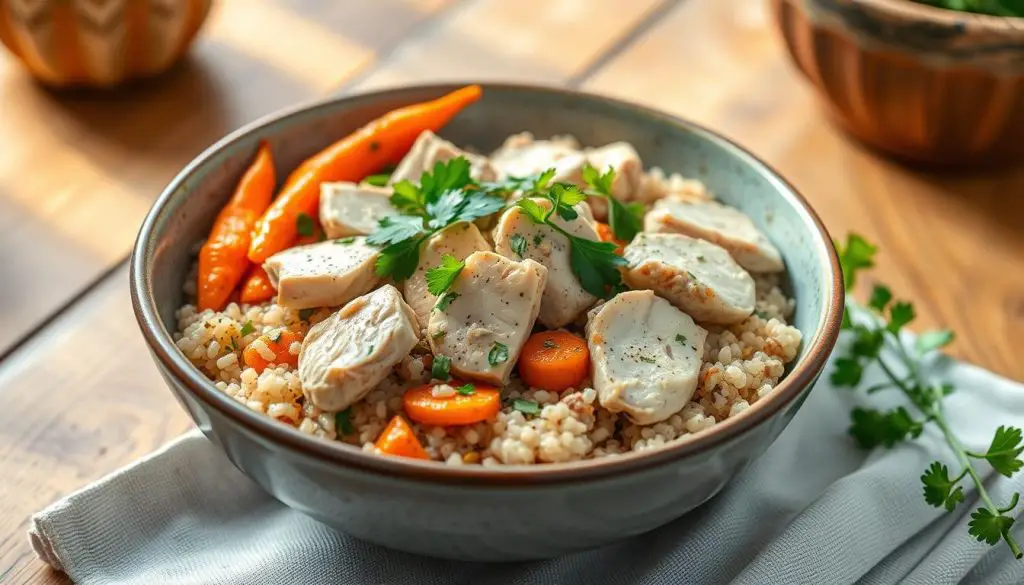
Meal Prep and Storage Tips
Preparing the Endo Friendly Chicken Quinoa Carrots dish in advance can make mealtime a breeze. You can roast the chicken and vegetables ahead of time. Store them separately in the refrigerator for up to 4 days. The quinoa can be cooked and stored in an airtight container for up to 5 days.
When you’re ready to serve, simply reheat the chicken and vegetables. Then, combine them with the quinoa.
For longer-term storage, the entire dish can be frozen for up to 3 months. Let it thaw in the refrigerator overnight before reheating and enjoying. These meal prep and storage tips make it easy to have endo friendly meals ready to go whenever you need them.
- Roast the chicken and vegetables, then store them separately in the refrigerator for up to 4 days.
- Cook the quinoa and store it in an airtight container in the fridge for up to 5 days.
- When ready to serve, reheat the chicken and vegetables, and combine with the quinoa.
- The dish can also be frozen for up to 3 months. Allow it to thaw in the refrigerator overnight before reheating and serving.
Convenient Meal Planning
By taking advantage of these make-ahead options, you can easily incorporate the Endo Friendly Chicken Quinoa Carrots into your weekly meal prep routine. This ensures you have a nourishing, endo friendly option on hand whenever you need it, making mealtime a breeze.
Endo Friendly Chicken Quinoa Carrots: A Low FODMAP Option
The Endo Friendly Chicken Quinoa Carrots recipe is not only anti-inflammatory. It’s also low in FODMAPs (Fermentable Oligosaccharides, Disaccharides, Monosaccharides, and Polyols). This is great for people with endometriosis who have digestive problems. It helps avoid foods that can upset the stomach, supporting gut health and easing bloating, constipation, or diarrhea.
The low FODMAP diet is good for managing digestive symptoms in those with endometriosis. Studies show it helps a lot, with 75% of IBS patients feeling better. They saw big improvements in stomach pain and bloating.
Adding fibrous foods like carrots, spinach, and quinoa to a low FODMAP diet is smart. It keeps the digestive system healthy and gives important nutrients. This recipe is perfect for those trying to manage their endometriosis diet and improve their gut health.
Always talk to a healthcare expert, like a dietitian or nutritionist, before trying a new diet. This is very important if you have a chronic condition like endometriosis. They can create a diet plan that fits your needs and helps with your digestive issues.
Nutritional Information and Health Benefits
The Endo Friendly Chicken Quinoa Carrots dish is full of vitamins, minerals, and macronutrients. These nutrients are great for people with endometriosis. The protein in the chicken, the fiber in the quinoa and carrots, and other nutrients make this meal a great choice for health and managing endometriosis symptoms.
Nutrients to Support Endometriosis Management
This dish contains:
- Protein from the chicken to support muscle recovery and tissue repair
- Fiber from the quinoa, carrots, and other vegetables to promote digestive health
- Antioxidants and anti-inflammatory compounds from the vegetables and herbs to reduce inflammation
- Complex carbohydrates from the quinoa to provide sustained energy
- Healthy fats from the olive oil to support hormone balance and brain function
Eating foods rich in these nutrients can help those with endometriosis. It can ease symptoms, reduce inflammation, and improve overall health. Adding this Endo Friendly Chicken Quinoa Carrots dish to your meals can help manage endometriosis through diet.
This dish is not just tasty; it’s also good for you. It’s packed with nutrients and has anti-inflammatory properties. Eating this can help support your health and reduce symptoms of endometriosis.
Adapting the Recipe for Personal Preferences
The Endo Friendly Chicken Quinoa Carrots recipe is made to be flexible. You can change it to fit your needs and dietary limits. If you have food allergies or just like different ingredients, this dish can be adjusted for you.
For those with endometriosis, eating anti-inflammatory foods is key. If chicken is a problem, use tofu or tempeh instead. You can also swap quinoa for brown rice or millet, both of which are gluten-free.
You can also change the veggies. Try adding zucchini, bell peppers, or asparagus. These add more nutrients and fiber. The goal is to mix in foods that are good for you and help with endometriosis symptoms.
It’s all about finding the right mix of flavors and nutrients for your body. Feel free to try new things and make the recipe your own!
| Ingredient | Substitution Options |
|---|---|
| Chicken | Tofu, tempeh, or other plant-based protein |
| Quinoa | Brown rice, millet, or other gluten-free grain |
| Carrots | Zucchini, bell peppers, or asparagus |
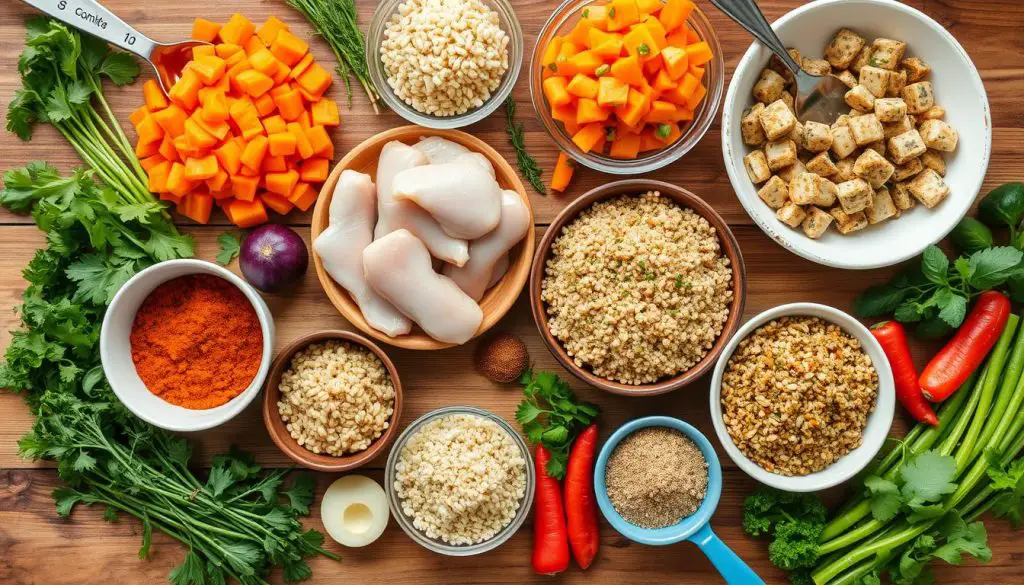
Complementary Side Dishes
To make a complete, endo-friendly meal, pair the Endo Friendly Chicken Quinoa Carrots with various side dishes. These sides boost the meal’s taste and look. They also help in fighting inflammation.
Nourishing Side Dish Ideas
- A fresh green salad with a balsamic vinaigrette dressing
- Roasted sweet potato wedges
- Sautéed leafy greens, like kale or spinach
- A side of steamed or roasted cruciferous vegetables, such as Brussels sprouts or cauliflower
- A serving of avocado or a small portion of healthy fats, like nuts or seeds
These side dishes not only match the flavors of the Endo Friendly Chicken Quinoa Carrots. They also add more anti-inflammatory and nutrient-rich qualities. By adding these elements, we can make a meal that’s both balanced and fulfilling.
Managing Endometriosis with a Holistic Approach
Managing endometriosis with a holistic approach can be very effective. Adopting an anti-inflammatory diet is a key step. But it works best when combined with lifestyle changes and complementary therapies. This way, individuals can find better relief from symptoms and manage the condition better.
Regular exercise is a big part of a holistic plan. Yoga, Pilates, and low-impact cardio help reduce inflammation and improve circulation. Stress management, like meditation and deep breathing, also helps with the emotional side of endometriosis.
Complementary therapies like acupuncture, herbal medicine, and massage can also help. These treatments aim to address the root causes of endometriosis, not just the symptoms.
By combining an anti-inflammatory diet, exercise, stress management, and complementary therapies, individuals can manage endometriosis better. This approach improves their quality of life.
| Holistic Endometriosis Management Strategies | Benefits |
|---|---|
| Anti-inflammatory diet | Reduces inflammation, supports immune function |
| Regular exercise | Improves circulation, reduces pain, boosts mood |
| Stress management | Helps manage emotional aspects of endometriosis |
| Complementary therapies (e.g., acupuncture, herbal medicine) | Aims to address root causes and provide symptom relief |
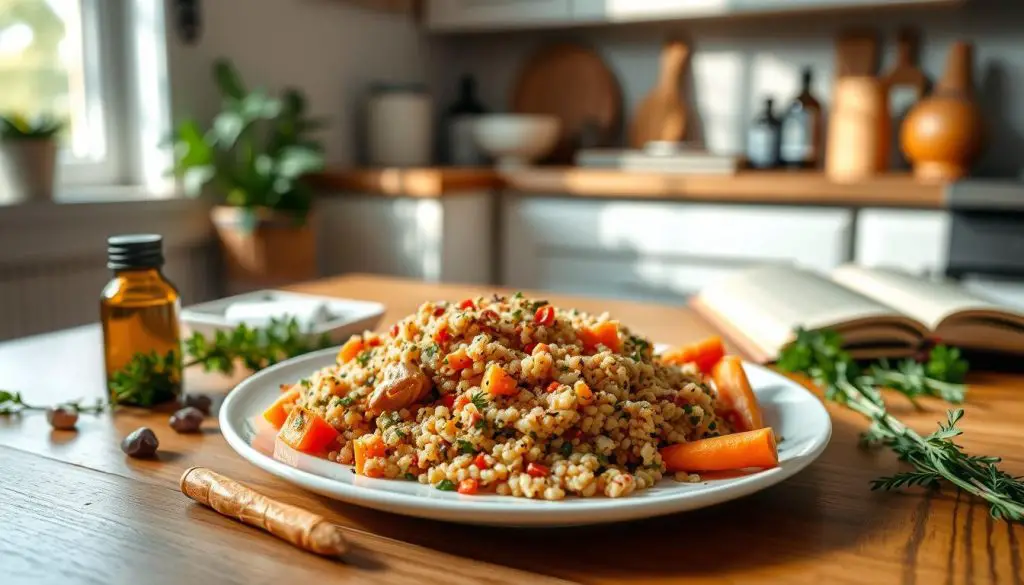
By taking a holistic approach to managing endometriosis, individuals can find a more effective way to address this chronic condition. This approach improves their overall quality of life.
Resources for Endometriosis Support and Education
For those with endometriosis, many resources are available. The Endometriosis Foundation of America and the Endometriosis Association are key. They offer information, support groups, and advocacy to help manage this condition.
It’s also important to find healthcare providers who specialize in endometriosis or women’s health. They can give personalized advice and help find the best treatments. This team approach is vital for a good management plan.
Online communities and support groups are great for sharing experiences and advice. They help reduce feelings of isolation. These spaces create a supportive network for those dealing with endometriosis.
Learning about endometriosis is key to making informed health decisions. Reliable sources like medical journals and patient organizations provide the latest information. This knowledge helps in managing symptoms and understanding new treatments.
By using these endometriosis support, education, and patient resources, people can better manage their condition. This leads to a better quality of life and a deeper understanding of endometriosis.
| Organization | Focus | Website |
|---|---|---|
| Endometriosis Foundation of America | Endometriosis education, advocacy, and support | www.endofound.org |
| Endometriosis Association | Endometriosis research, support, and awareness | www.endometriosisassn.org |
| International Endometriosis Association | Global endometriosis support and education | www.endometriosis.org |
Final Thoughts on Endo Friendly Eating
Adopting an endo-friendly diet, like the Chicken Quinoa Carrots recipe, can help manage endometriosis symptoms. It focuses on anti-inflammatory, nutrient-rich foods. This can support our health and help find relief from endometriosis’s effects.
Diet alone can’t cure endometriosis, but it’s a key part of managing it. By trying endo-friendly recipes and living a balanced life, we can improve our care. This can lead to a better quality of life.
It’s important to listen to our bodies and find what works for us. With some trial and error, we can find the best endo-friendly foods and strategies. By focusing on our health and nourishing our bodies, we can take control of managing endometriosis.
Source Links
- https://www.businessinsider.com/guides/health/conditions-symptoms/endometriosis-diet
- https://www.ssmhealth.com/SSMHealth/media/Documents/slucare/services/obstetrics-gynecology-womens-health/endometriosis-diet-booklet.pdf
- https://www.verywellhealth.com/endometriosis-diet-7105372
- https://nzendo.org.nz/endo-news/mediterranean-diet/
- https://healthunlocked.com/endometriosis-uk/posts/143148661/endometriosis-diet-meal-ideas-informative-post-add-yours-to-it-and-share
- https://endometriosisnews.com/2018/08/02/nutrition-endometriosis-what-i-really-eat-day-part-2-lunch/
- https://birlafertility.com/blogs/what-to-eat-and-what-to-avoid-in-endometriosis/
- https://sofreshnsogreen.com/recipes/endometriosis-diet-recipes/
- https://bigsisnutrition.com.au/resources/nutrition-for-adenomyosis/
- https://healthunlocked.com/endometriosis-uk/posts/143082456/struggling-to-eat
- https://thedietologist.com.au/two-week-wait-diet/
- https://www.usenourish.com/blog/endometriosis-diet-grocery-list
- https://www.everydayhealth.com/diet-nutrition/endomorph-diet/
- https://www.acibademhealthpoint.com/healthy-endometriosis-recipes-for-relief-comfort/
- https://www.healendo.com/food-inspo
- https://www.endo-gym.com/food
- https://everything-delish.com/anti-inflammatory-turmeric-roasted-veggie-quinoa-bowl-with-jammy-eggs-garlicky-tahini/
- https://sofreshnsogreen.com/recipes/paleo-butter-chicken/
- https://www.inovifertility.com/blog/fertility-meal-prep-ideas/
- https://supremerestaurant.nyc/meal-plans-for-fitness/
- https://www.everydayhealth.com/mediterranean-diet/complete-mediterranean-diet-food-list-day-meal-plan/
- https://myacare.com/blog/digestion-problems-try-the-low-fodmap-diet
- https://thyroidpharmacist.com/articles/low-fodmap-diet-sibo-ibs-hashimotos/
- https://www.ibsdiets.org/fodmap-diet/fodmap-food-list/
- https://joythebaker.com/2019/03/six-weekday-meals-im-eating-right-now/
- https://www.theroastedroot.net/immunity-boosting-turmeric-chicken-soup/
- https://www.usenourish.com/blog/7-day-meal-plan-for-gastritis
- https://floliving.com/blog-categories/endometriosis
- https://icarebetter.com/category/endometriosis-education/endometriosis/
- https://healthunlocked.com/endometriosis-uk/posts/143543902/has-the-endo-anti-inflammatory-diet-worked-for-you
- https://drkathleenmahannah.com/blog/endometriosis-foods-to-eat-and-avoid
